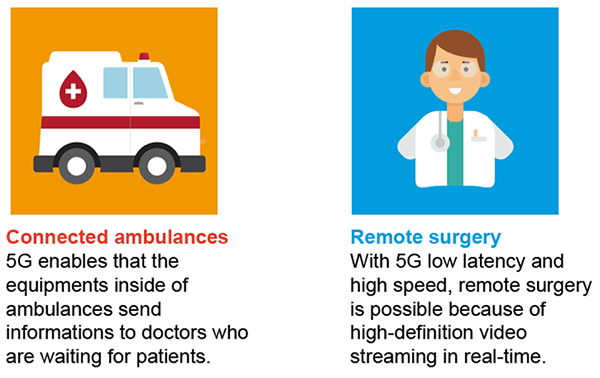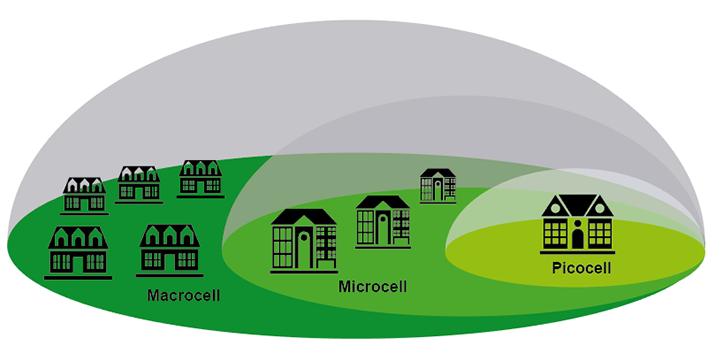IoT, Healthcare, and Medicine: Future Perspectives
We can say that the integration of IoT with Healthcare started with smartwatches monitoring some signals and storing this data in the cloud. With 5G and WiFi 6 networks accelerating the internet connection speeds, and at the same time, the Artificial Intelligence offering better analytics tools, sensors technological improvements more companies in the market are launching new IoT products, including healthcare IoT products.
The link between IoT with Health and Medicine sectors is so strong that subcategories have emerged: IoMT (Internet of Medical Things) that encompass an array of internet-capable medical devices that are in constant communication with each other or with the cloud; IoHT (Internet of Healthcare Things) that is the digital transformation of the healthcare industry. This article presents some of the new IoT for healthcare and medicine that are emerging with the arrival of the new 5G and WiFi 6 fast networks and new types of sensors.
Connectivity, IoT, Healthcare, and Medicine
The introduction of 5G mobile networks and Wi-Fi 6 networks (that is the 802.11ax standard approved by the IEEE in February 2021) will enable much faster communications and less latency, that is, with less data delay time. This faster communication will enable IoT devices efficient communication between devices, doctors, and patients. For example, we can have ambulances connected to hospitals, that is, the equipment inside of the ambulance is transmitting information to doctors who are waiting for patients in the hospitals and are already monitoring such patients, thus getting ready for faster patient care [1]. Remote surgery will become a reality because low latency and high speeds of the new internet networks that will provide high-resolution videos in real-time so that the doctor can, through robotics, perform surgeries on patients in distant locations [2].

Figure 1: Connected ambulances and Remote surgery.
IoT and Healthcare are the basis of Body Sensor Networks (BSN), which proposes the development of miniaturized wireless sensing systems for continuous capturing of physiological signals and information and storing in the cloud. The BSN will require an omnipresent communication with the cloud that will be possible with 5G networks using the concepts of Femtocell, Picocell Microcell, and Macrocell [3].

Figure 2: 5G base station types.
Sensors for Healthcare and Medicine
The new generation of radar sensors based on mmWave frequencies above 60 GHz and are sensitive enough to sense even a heartbeat [4] or used to detect human gestures like elderly fall-detection [5]. These radar sensors manufactured by companies like Infineon [6] can replace traditional cameras in many situations protecting people’s privacy during its operation and their ability to operate efficiently in environments where there are light and sound interferences as well as adverse atmospheres. Therefore, the mmWave radar sensors can be used in healthcare monitoring situations. Soon, ultra-compact spectrum sensors such as the Hamamatsu [7] and Ibsen Photonics [8] ones may be integrated into smartphones and will open up a range of possibilities for healthcare, ranging from the identification of contaminated or spoiled foods to the identification of diseases in the human body. These spectrum sensors will bring a great revolution to society.
Healthcare Smart Environment and IoT
Wearables, such as fitness trackers, heartbeat, blood glucose monitors, and other connected medical devices, have already achieved people very quickly. However, all of these wearables are in contact with the people being monitored.
The future for health and medical technologies is to monitor people without any physical contact and autonomously, being invisible to the people being monitored. The people will receive a report with their health situation and preventive actions to improve their health without using any wearable device.
Companies and startups like Imec [9], bitsensing, and Invisible Monitor [10] are already developing systems for monitoring vital signs without physical contact that will soon be available on the market and all solutions presented are based on the Internet of Things and Artificial Intelligence.
Challenges and Opportunities
For this ubiquitous monitoring future to be possible, millions or billions of connected smart sensors are needed, and IoT is the answer to turn this future possible. However, it is important to remember that all of these sensors produce large amounts of information that need to be stored and analyzed using Artificial Intelligence so that all data collected on the IoT has relevance to people and society.
References
- O. Udawant, et al., "Smart ambulance system using IoT", International Conference on Big Data, IoT and Data Science (BID), 2017
- H. Su, et al., "Internet of Things (IoT)-based Collaborative Control of a Redundant Manipulator for Teleoperated Minimally Invasive Surgeries", IEEE International Conference on Robotics and Automation (ICRA), 2020
- Qorvo, Small Cell Networks and the Evolution of 5G (Part 1), https://www.qorvo.com/design-hub/blog/small-cell-networks-and-the-evolution-of-5g, (accessed Mar. 15, 2021).
- S. Dong, et al., “Doppler Cardiogram: A Remote Detection of Human Heart Activities”, IEEE Transactions on Microwave Theory and Techniques, 2020, v.68, i.3
- E. L. Chuma, et al., "Internet of Things (IoT) Privacy–Protected, Fall-Detection System for the Elderly Using the Radar Sensors and Deep Learning", IEEE International Smart Cities Conference (ISC2), 2020
- Infineon, Radar sensors for IoT, https://www.infineon.com/cms/en/product/sensor/radar-sensors/radar-sensors-for-iot/, (accessed Mar. 15, 2021).
- Hamamatsu, MEMS-FPI spectrum sensors, https://www.hamamatsu.com/us/en/product/optical-sensors/spectrometers/mems-fpi-spectrum-sensor/index.html, (accessed Mar. 15, 2021).
- Ibsen Photonics, PEBBLE Ultra-Compact OEM Spectrometers, https://ibsen.com/products/oem-spectrometers/pebble-spectrometers/, (accessed Mar.1 5, 2021).
- Imec, Technology for vital sign monitoring devices, https://www.imec-int.com/en/connected-health-solutions/vital-sign-monitoring, (accessed Mar. 15, 2021).
- Invisible Monitor, Contactless sensors to health monitoring, http://invisiblemonitor.com/site/about/, (accessed Mar. 15, 2021).
 Euclides Lourenço Chuma earned a degree in Mathematics (2003) from the University of Campinas (UNICAMP), a graduate degree in network and telecommunications Systems (2015) at INATEL, an M.Sc. in electrical engineering (2017) at UNICAMP, and a Ph.D. in electrical engineering (2019) at UNICAMP, SP-Brazil. His research interests are microwave, millimeter-wave, photonics, bioengineering, sensors, wireless power transfer, and telecommunications.
Euclides Lourenço Chuma earned a degree in Mathematics (2003) from the University of Campinas (UNICAMP), a graduate degree in network and telecommunications Systems (2015) at INATEL, an M.Sc. in electrical engineering (2017) at UNICAMP, and a Ph.D. in electrical engineering (2019) at UNICAMP, SP-Brazil. His research interests are microwave, millimeter-wave, photonics, bioengineering, sensors, wireless power transfer, and telecommunications.
Sign Up for IoT Technical Community Updates
Calendar of Events
IEEE 8th World Forum on Internet of Things (WF-IoT) 2022
26 October-11 November 2022
Call for Papers
IEEE Internet of Things Journal
Special issue on Towards Intelligence for Space-Air-Ground Integrated Internet of Things
Submission Deadline: 1 November 2022
Special issue on Smart Blockchain for IoT Trust, Security and Privacy
Submission Deadline: 15 November 2022
Past Issues
September 2022
July 2022
March 2022
January 2022
November 2021
September 2021
July 2021
May 2021
March 2021
January 2021
November 2020
July 2020
May 2020
March 2020
January 2020
November 2019
September 2019
July 2019
May 2019
March 2019
January 2019
November 2018
September 2018
July 2018
May 2018
March 2018
January 2018
November 2017
September 2017
July 2017
May 2017
March 2017
January 2017
November 2016
September 2016
July 2016
May 2016
March 2016
January 2016
November 2015
September 2015
July 2015
May 2015
March 2015
January 2015
November 2014
September 2014



Comments
2021-03-23 @ 4:50 AM by Shekhawat, Rajveer
Hello Dr. Chuma, you have nicely captured shape of things to come and the central role IoT is going to play. We have to, however, note that all the sensor data can not be pumped up to the cloud and thus we need to evolve edge analytics methods which can be deployed right near the sensor, ths avoiding huge amount of data to be uploaded, improve response time, and maintain privacy of sensitive health data. Light-weight machine learning and encryption algorithms is the need of hour, nothwithstanding the rapid rise in computing power of edge hardware.